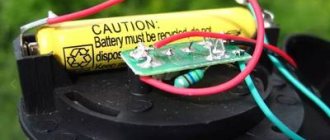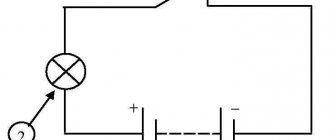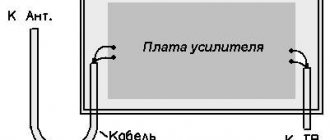Garden lamps powered by solar panels are a convenient and completely autonomous solution. There is no need to run a cable or spend money on communications; the equipment is inexpensive, and if desired, you can do it yourself. All components are on sale, you need to study the diagram, buy everything you need and carry out the work according to simple instructions.
A homemade garden light can be stylish.
Solar lamp device
First of all, you need to understand what parts the structure consists of and how it works. Garden lamps have a simple design, since they only have what is needed:
- A housing containing parts. Most often this is a plastic casing at the top, and the bottom is made in the form of a post tapering downward so that it can simply be stuck into the ground. The plastic is weather-resistant and impact-resistant, so it is not damaged by ultraviolet radiation and does not crack due to accidental impacts.
- Protective glass. There is a flat element at the top and a diffuser on the side. Most often, the manufacturing material is polymers, so even if broken, there will be no dangerous fragments on the site.
- Solar cell, usually a small cell with an area of about 9 square centimeters. The quality may vary, which is why the lamps work differently. When choosing a finished option, you need to carefully examine the surface of the panel; it should be perfectly smooth, without cracks or damage.
- The battery stores the energy converted by the solar battery to ensure the operation of the lamp in the dark. Capacity and design may vary, it all depends on the price of the product. When purchasing, you can clarify this point, since the battery life directly depends on it.
- LEDs provide good illumination with minimal energy consumption. The quantity depends on the brightness; usually small options are installed that save electricity.
- A photoresistor or light sensor automatically turns on the lighting in the area in the evening. When the amount of light in this node decreases, the resistance changes and the light comes on.
- The control board is a connecting element that connects all nodes and ensures their operation.
Garden lights can make the area much cozier.
If you need an AA battery, you can buy the cheapest garden light. From there you can remove the battery and its price will be several times cheaper than if purchased separately.
This option has many advantages:
- Autonomous: no need to do wiring, make a project, etc. You can simply place the lamp anywhere and it will immediately start working.
- The equipment provides diffuse lighting that does not hurt the eyes, but provides good visibility in the area in the dark.
- No care or maintenance required. It is enough to wipe the dust several times a season so that the solar battery accumulates energy more easily and the light dissipates better.
- The lamps are safe for children and pets. They do not contain any harmful substances or sharp parts.
There are a lot of different models on sale.
By the way! If there are cases left from old, broken garden lamps, they can be used to make homemade versions. This will make the job easier.
Pros and cons of a homemade device
In country houses there are often interruptions in electricity, or it is completely absent. The desire to make a lighting design for a garden plot can have great difficulties when laying wires. DIY LED flashlights will help solve the problem.
Their creation and use is associated with the following advantages :
can be made from inexpensive scrap materials;- do not require professional skills during assembly;
- easy to install and dismantle as needed;
- does not require any energy source other than natural light;
- does not involve expenses during operation;
- environmental friendliness of the device.
Despite the visible advantages, a homemade LED flashlight also has some disadvantages :
- In order for the flashlight to work, you will have to work on quality connections;
- if you install it in a dark place, the batteries will not be replenished and the LED will light up;
- when working on a lamp you will need to use tools that not everyone knows how to use;
- you will need to purchase some parts for the circuit board and organizing the parts of the lamp, which contributes to costs;
- cannot be repaired if broken.
Electrical diagram
Shown here is the simplest diagram that even a novice craftsman who has never created garden lamps and other similar products can figure out. The system has only 7 components.
Using this diagram, assembling a garden lamp will not be difficult.
To understand the diagram and understand why certain parts are needed, you need to consider how the finished product works:
- When sunlight hits the surface, the transistor is in the off state. Therefore, the accumulated energy is supplied to the battery and charges it.
- After sunset, when no light reaches the photocell, the transistor opens and voltage is supplied to the LEDs. That is, the equipment is charged for as long as possible during the day, and turned on at dusk.
- The operating time of the lamp directly depends on the battery capacity and the power of the LEDs used in the design. Usually the components are selected so that they are enough for 6-8 hours of work.
Approximate expenses
The cost estimate for creating a garden solar lantern is difficult to estimate due to the difference in design elements. If you use available materials, the costs will be small. To purchase a board and other radio components you will need no more than 500 rubles.
The most expensive part will be the solar panel . Its cost can start from 10 rubles to 1000 rubles, depending on the quality of the product and the brand. The most expensive elements will last a long time and delight the owner of the site with bright light.
Cheap boards break quickly and may not work immediately after manufacture. Additional costs may include PVC pipes. The best option is to find an alternative to them, or use existing supplies.
The expense table might look like this:
| Details | Price | Quantity | Purchase amount |
| Solar panels | 170 rub. | 1 PC. | 170 rub. |
| Storage battery | 220 rub. | 1 PC. | 220 rub. |
| LEDs | 12 rub. | 3 pcs. | 36 rub. |
| Resistor | 2 rub. | 6 pcs. | 12 rub. |
| Transistor | 5 rub. | 3 pcs. | 15 rub. |
| Diode | 3 rub. | 3 pcs. | 9 rub. |
| total amount | 462 rub. |
A budget option for one LED flashlight will cost about 500 rubles, according to the table. You can purchase what you need to create it in bulk in order to collect several products of this type at once, then the total purchase amount will be even lower per unit of luminous device.
List of required parts
There are only 7 elements in this list; most of the parts can be found in an electronics store. But to save money, you can order components through Aliexpress or other similar sites. The main thing is to select all the parts according to the markings so that you end up with a workable design:
- 3.6 kOhm resistor.
- 33 Ohm resistors (depending on the number and power of LEDs).
- Diode 1N5391 or analogues (there are both imported and domestic options).
- Transistor 2N4403 (there may be other types with suitable characteristics).
- Rechargeable battery 3.6 V. It is better to choose lithium-ion ones, since nickel-cadmium ones are not reliable.
- Solar photopanel, monocrystalline options are best suited as the most productive and durable. Polycrystalline elements can also be used. The main thing is to choose products of grade A or B, do not take options C and especially D, since their characteristics are much worse and their service life is shorter.
- LEDs. You can use 1 element with a power of 3 W, but it is better to take 3 pieces with a power of 1 W. In this case, it is good to use DIP diodes as they perform better in open air conditions than SMD.
Parts you need to have on hand when assembling a garden light.
It is worth deciding in advance in which housing to arrange all the nodes. Any options that provide a convenient arrangement of parts are suitable. You also need to purchase a soldering iron and all materials for soldering if they are not at hand.
Main characteristics
The quality of such a device is determined by the silicon used. In inexpensive lamps, polycrystalline or amorphous varieties are used. Monocrystalline silicon can work in any season, it is resistant to aggressive influences. If it is not possible to purchase a monocrystalline element, it is better to use multicrystalline solar cells.
To give durability to the products, they are covered with a special film.
Manufacturers began to invent marketing techniques to hide some of the flaws in their products. In particular, polycrystalline devices have come to be called LED street lights, but their normal service life will be only one season.
Branded devices boast a long service life. There is a fairly powerful photocell here; sunlight penetrates into the deep layers, which ensures stable operation of the lamps for a long time. In Chinese lamps, the thickness of the photocell is comparable to foil, so its service life is much shorter.
The structure of the glass also influences lighting. When days with cloudy weather prevail, it is better to use textured glass, since it accumulates radiation, while a smooth surface contributes to its partial reflection. The most expensive and durable coating is tempered glass.
Lantern layout
You need to carry out your work on a table that is well lit and has everything you need at hand. You may need tweezers, a knife and other tools. It's also a good idea to have some wires on hand. There are two ways to connect parts according to the diagram:
- Use a universal circuit board or make your own. In this case, the main components will be arranged in one place and securely fastened. The easiest way to buy one is in radio electronics stores; there are options of different sizes, so it’s not difficult to choose.
- If the board is not at hand, you can connect the parts using a hinged method. All parts have long legs, so they can be connected even without the use of wires, but if you need to move some parts further away (for example, take a solar panel outside or expose LEDs), use copper wires in insulation.
Think about the location of the parts in advance, lay them out and try them on to understand how best to connect them. At this stage, you can make amendments and avoid mistakes and difficulties.
The board is used in all ready-made lamps.
What to make a lampshade from and how to assemble a lamp
After choosing a layout option, you need to select a housing to protect the products from atmospheric influences. This can be a small plastic container that closes tightly or a glass jar with a lid. To make a solar-powered lamp with your own hands, you need to follow the instructions:
- Attach the solar battery to the selected lampshade (its upper part). Contacts must be attached to it; if there are none, a contact track is soldered in. It’s best to stick it with double-sided tape, but don’t press it hard. Pass the contacts through a cover or other element, after making small holes in suitable places. Once the wires are in place, seal the holes with a small amount of weatherproof sealant to prevent moisture from penetrating inside.
- Inside the case you need to secure the battery compartment; the easiest way is to glue it with sealant or a glue gun. Next, arrange all the other parts according to the diagram, connecting them securely. If the work does not use a printed circuit board, you can attach a small piece of foam and insert the legs of the electronic elements into it so that they are firmly fixed.
- LEDs are usually located at the bottom. If you use a jar, you don’t need to do anything special. But to increase the brightness, you can assemble a reflector using thick foil or a CD cut into suitable size pieces. It is difficult to determine the quality of lighting the first time; it is better to try different options to choose the one that will shine best.
- If an opaque lampshade is used, then one of its walls or lower part must be cut out and a diffuser or piece of transparent plastic of a suitable size must be inserted. Here you need to proceed from the situation and select what is at hand. You can use diffusers or glass from old lamps or flashlights. To secure the element and make the connection waterproof, it is better to use a transparent sealant that is UV resistant.
- After connecting all the parts of the circuit, it is necessary to check its functionality. If everything is fine, the connections need to be sealed with a special pencil or contact compound. Before assembling the case, you should warm it up from the inside with a hairdryer to remove excess moisture and prevent oxidation processes inside.
- You can attach a leg to the finished lamp to stick it into the ground in a suitable place, or you can hang it. The easiest way to do this is to make a hook or loop on the outside.
Review of solar wall street lights with motion sensors
Pros:
- Does not require electrical wiring. Bought it, attached it and use it.
- Energy saving.
- In the conditions of central Russia, solar-powered street wall lamps without motion sensors do not shine all night long, since the battery does not have time to fully charge under our usually gloomy sky. The motion sensor saves battery power.
Minuses:
- The mounting location of the lamp should be such that the solar battery is located in direct sunlight.
- In winter, snow falls on the solar panel and it stops working.
- The battery will have to be replaced sooner or later.
- They only light up when a person walks by. For decorative lighting of the landscape, you should use lamps without motion sensors that illuminate the space constantly.
Popular model with good design. There is a motion sensor, the operating range depends on the location of the lamp. LEDs - 16 pcs. Protection level: IP65. Li-ion battery: 3.7 V, 1000 mAh. Brightness: 100 lm. Price: 929 rubles for 2 pieces. ..
Plastic case. Protection: IP65. Lithium rechargeable battery 3.7 V / 900 mAh. LEDs - 16 pcs. Weight: 185 g. The motion sensor is triggered at a distance of 3-5 m. Price: 428 rubles.
Popular and nice model with a motion sensor. The sensor's response range depends on the location of the lamp. Aluminum body with plastic. LEDs - 20 pcs. Color temperature 5500-6000 K. Protection level: IP55. Battery Ni-MH 1000 mAh/3.7 V. Brightness: 340-600 lm. Price: 841 rub. ..
A convenient design with a loop allows you to easily remove the lamp from the wall (for example, to put it away for the winter). According to the seller, the motion sensor works for 8 meters (in reality it is probably less). The light turns on for 20 seconds and if there is no movement within the sensor's coverage area, the light turns off. Quite dim, LEDs - 6 pcs. Lithium battery: 600mA, 3.7 V. Price: 964 rub. .. There may be cheaper ones in a white case, but we managed to find them only for 822 rubles. ..
Housing made of stainless steel and plastic. Housing protection IP65. Lithium battery 3.7 V / 2200 mAh. LEDs - 8 pcs. The light is warm white or cool white to choose from. Two operating modes. When there is no movement, the brightness is 20 lumens. When a person passes by 2000 lumens - 18 seconds. Price: 587 rub. ..
Two body color options (black and white). Protection level: IP65. Several operating modes. One of them lights up dimly, but when the motion sensor is triggered, it lights up at full power. The way the lamp is mounted makes it easy to remove it from the wall. Li-ion battery: 3.7 V / 1000 mAh. LEDs - 16 pcs. Price: 696 rub.
Solar-powered LED wall-mounted street lamp with a rotating mechanism. LEDs: 18 pcs. Housing protection degree: IP65. Price: 1,039 rub. ..
LED wall street lamp powered by a solar battery. LEDs: 17 pcs. Housing protection degree: IP65. Price: 317 - 1,265 rub. .. 46 LEDs. Lithium-ion battery 3.7 V / 1700 mAh. Protection level: IP65. Body color black or white. There is a motion sensor. Price: 1,272 rub. .. Bright lamp with 118 LEDs. Housing protection: IP65. 3 operating modes. Motion Sensor. Price: 1,033 rub. ..
Wall lamp with 14 LEDs with a rotating mechanism. Brightness - 70 LM. Housing protection: IP65. Motion Sensor. Price: 1,742 rub. ..
For sections of walls located in the shade, outdoor wall lamps are used to allow the solar panel to be exposed to the sun.
Outdoor LED lamp with remote solar battery. Brightness: 180LM. Motion Sensor. LEDs - 56 pcs. Price: 1116 rub. ..
Outdoor LED lamp with remote solar battery. Housing available in white or black. Motion Sensor. Brightness: 450 LM. LEDs - 22 pcs. Price: 828 rub. ..
Outdoor LED lamp with remote solar battery. Motion Sensor. Brightness: 750 LM. Price: 1900 rub. ..
Outdoor LED lamp with remote solar battery. Housing available in white or black. Motion Sensor. Brightness: 1000 LM. LEDs - 188 pcs. Color temperature: 6000 K. Price: RUB 2,704.
How can you improve the finished model?
If the purchased garden lights do not work as expected, or their characteristics do not correspond to the declared ones, some modifications can be made. They will help improve the design and provide high-quality light:
- If the lamp produces dim light, it is worth disassembling it and removing one of the resistors. A jumper is placed in its place; everything must be done carefully so as not to damage other components. Usually this is enough for the brightness to increase by an order of magnitude.
- When the light starts out bright, but after a short period of time becomes dim and then goes out, you need to add a resistor of about 50 kOhm. This will allow the system to shine brightly for at least a few more hours.
- Another common problem is that the lights go out several hours after dark. Most often this happens due to the fact that the manufacturer saved on the battery and supplied an option with a small capacity. You need to disassemble the case and check the battery rating, if it is 600 mAh or less, change it to a model with 1000 mAh or more, it all depends on the performance of the solar module. Select a battery based on 8 hours of LED operation plus a reserve of approximately 30%.
- Some models have only one LED, which does not provide high-quality light. In this case, you need to clarify its power, then select 3 diodes, which in total will consume approximately the same amount of energy and place them around the perimeter of the lampshade at an angle of approximately 120 degrees.
- Instead of a standard LED, you can solder in an RGB version and then the light will be iridescent.
The design of ready-made lamps is simple; understanding it will not be difficult.
To save energy and turn on a garden lamp only when needed, you can solder a small switch into the circuit.
Anyone with at least basic soldering skills can make a garden lamp with their own hands. You can buy components online or in a radio electronics store. Also, using the recommendations, it is easy to repair or improve the operation of finished lamps.
How does a garden lamp work?
The absence of a power connection makes the LED flashlight a very convenient and cost-effective way of lighting. During the day, while the sun is shining, the flashlight stores solar energy in its battery.
The weather must be cloudless and clear to collect light as efficiently as possible. Some flashlights have a controller inside that turns on the light as soon as it gets dark enough outside. Then the accumulated energy in the batteries begins to be consumed.
When completely discharged, the lamp stops producing light. The work looks like this :
- During the day, the storage panel converts the sun's energy into low-power electricity.
- The resulting energy is redirected to the battery using a diode.
- The positive potential through a resistor controls the absence of glow before dark.
- As soon as dusk or another type of dimming sets in, the transistor turns on (the effect is obtained due to a small positive potential in contact with the base) and starts the LED to glow based on the energy contained in the battery. The flashlight emits light.
- The light diode evenly doses the energy production from the battery to prevent complete discharge.
- As soon as it starts to brighten, the positive voltage cuts off the transistor, as a result of which the LED stops receiving energy to glow. During this period, the battery charging process starts again.
Simpler models without a controller accumulate energy and spend it evenly, providing glow at any time of the day.
Basics and composition of solar stations
The purpose of solar panels is to collect and concentrate (attract) sunlight (ultraviolet), convert it through controllers, an inverter into electricity and supply it through batteries or directly to the 220 V (or 380 V) network at home.
Excess electricity can be sold. One of the advantages of the system is complete autonomy and automaticity. Disadvantage: dependence on weather, climate, shading.
The user’s standard goal is to select elements so that they pay for themselves in the shortest possible time. Therefore, correct assembly is very important - the efficiency of the equipment depends on it.
Lamps for installation on fence or gate posts
The case is plastic. An exclusively decorative element of the landscape, it shines dimly (1 LED), but allows you to place these flashlights at eye level. Housing protection degree: IP33. Price: 690 rub.
The body is plastic, but made neatly. An exclusively decorative element of the landscape, it shines dimly, which allows you to place these lanterns at eye level. Housing protection degree: IP33. Price: RUB 2,092
Purpose and calculation of an additional resistor in the LED power circuit
The battery voltage may be too high for the LED (this may cause it to fail). To compensate for its excess we use an additional resistor R2. We calculate its denomination based on the formula: U(A) = U(D2) + U(R2), where:
U(A) – battery voltage;
U(D2) – LED operating voltage;
U(R2) – voltage drop across additional resistor R2.
For the TDS-P001L4U15 LED used in the above circuit with an operating voltage of 3.7 V, the use of resistor R2 is not required, since U(A) = U(D2). That is, our specific scheme will look like this:
As an example of calculating additional resistors, consider a circuit with the connection of two different types of LEDs: D2 - BL-L813UWC (operating voltage - 2.7 V; current consumption - 30 mA; cost - 15 rubles) and D3 - FYL-5013UWC/P (2, 2 V; 25 mA; 20 rubles).
We calculate the additional resistor R2 for LED D2.
U(A) = U(D2) + U(R2)
U(R2) = U(A) – U(D2) = 3.7 – 2.7 = 1 V
According to Ohm's law (familiar to everyone from school):
U(R2) = R2 • I, where I is the current consumed by the LED, therefore
R2 = U(R2) : I = 1 : 0.03 = 33.33 ≈ 33 Ohm
Similarly, we calculate the additional resistor R3 for LED D3:
U(R3) = U(A) – U(D3) = 3.7 – 2.2 = 1.5 V
R3 = U(R3) : I = 1.5 : 0.025 = 60 ≈ 62 Ohm
On a note! After calculations have been made, the values of additional resistors are rounded to the nearest standard values.
The final circuit with two different types of emitters will look like this:
Design and assembly of the lamp
The lamp requires a housing, preferably waterproof. It is very convenient to use an empty canning jar with a screw-on lid.
Example of parts layout
To assemble such a lamp, you need a piece of plywood to glue two rows of modules onto it. The proposed photocells have a size of 52x19 mm; folding them in two rows will result in a rectangle with dimensions of approximately 110x110. You can glue the modules using double-sided tape for mirrors, but do not press down too hard.
Before gluing the modules, cut a hole in the center of the board for the lid of the jar and secure it inside with a couple of drops of hot glue. You need to pierce two holes in the cover to enter wiring from the modules; do not forget to restore the seal later.
To conveniently place electronics inside, glue a small foam washer to the inside of the lid. If you don’t bite the legs when soldering the circuit, you can stick the elements into the foam and fix them that way. And if you make rectangular cuts in the foam, you can easily insert batteries into them. For contact, use a pair of flattened balls of aluminum foil with wires soldered to them.
Before closing the lid, warm the inside of the jar well with a hairdryer. This way the parts will oxidize less, and condensation will not appear on the walls of the jar.
Centralized solar lighting
If the cottage is connected to a central power supply and has wiring, it is advisable to use solar modules to generate electricity, which will be used for the needs of the entire house. This will require special modules, which are usually installed on the roof.
Lighting at the dacha with your own hands using alternative energy is organized in several stages.
- Selecting and purchasing a solar battery.
- Supporting elements and brackets are attached to the surface where the batteries will be installed.
- The slats are attached to the fixing elements.
- After the slats are installed, the solar panels themselves are placed on them.
- Using the wiring included in the kit, a connection is made to the existing wiring system of the dacha.
Functional characteristics depend on power. To provide light to a country house, modules with a power of 12-24 V are sufficient.
The standard solar battery kit includes:
- battery charge controller;
- inverter;
- wiring;
- circuit breakers;
- connectors;
- circuit breakers.
Some models may include additional elements. For example, some contain an energy meter to monitor energy consumption.
If wires are laid in the ground, street lighting is also connected using such a system. Essentially, the house's wiring will have the exact same electricity, just converted from solar energy.
A set of components for a solar-powered lantern
Before you start purchasing parts, you need to decide how many lamps will be installed and in what places. What will be their power? Having decided on this, you can begin to select components for the lamps.
Naturally, for a solar-powered lantern, you first need to purchase solar modules. Helium converters of various modifications, quality and efficiency are available for sale. If we consider that the main purpose of these converters is only to charge the battery during daylight hours, then it is quite enough to purchase at retail a certain number of solar modules, from which, if necessary, you can assemble a sufficiently powerful battery.
For these purposes, a solar battery based on polycrystalline silicon 5.5 V, 90 mA, having dimensions 65x65x3 mm, is quite suitable. This battery is laminated with silicone, thanks to which the battery is completely protected from all kinds of mechanical influences and moisture. This also made it possible to reduce the weight of the battery to a minimum - only 15 grams. The battery is ideal for charging 3.6 V – 4.8 V batteries. The retail cost of the battery is 137 rubles.
Solar panels Solar Panel 65×65
The next component of the lamp is the battery. A lithium-ion battery with an output voltage of 3.6 V and a capacity of at least 3000 mAh is quite suitable for it.
From the relatively inexpensive batteries available on the market, you can choose a set consisting of four lithium-ion batteries model 18650. Each battery has an output voltage of 3.7 V with a capacity of 9800 mAh. The package also includes a charger, which may be quite useful, for example, for the initial charging of batteries. The batteries have the following dimensions: diameter – 17 mm, height – 65 mm. The price of the set (with charger) is 411 rubles.
18650 battery kit with charger
Next you need to select a luminous element. The most suitable for these purposes is LED. You can, of course, use LED lamps, but they will consume too much energy. Modern LEDs with increased brightness can satisfy any need, since they can be installed in the required quantity for each specific lamp.
For such flashlights, a five-millimeter super-bright white LED of type 3H5 (helmet) is quite suitable. It is usually used in outdoor advertising, in various electronic displays, and in road signs. So it is quite suitable for a flashlight. It can be operated at temperatures from -55°C to +50°C. The cost of one such LED is 10 rubles.
Ultra-bright white LED type 3H5 (helmet)
And finally, the heart of the lamp is the electronic control unit. His circuit contains four resistors, costing 1.5 rubles each, two KT503 type transistors, costing 9 rubles each, one Schottky diode 11DQ04, costing 24 rubles. This is all located on one board.
Transistor KT503
resistor MLT 22 kOhm
Schottky diode 11DQ04
The solar battery, battery, and LED are connected separately. You can, of course, assemble all this on a piece of polystyrene foam, PCB, or cardboard. But no self-respecting master who collects something for himself would allow himself such sloppiness.
To install the block, it is not at all necessary to draw and etch the printed circuit board. A universal DIY PCB 42x25mm breadboard is perfect for these purposes. This board is designed specifically for mounting and configuring your own electronic circuits. It is made of high quality materials and has gold-plated contacts. The dimensions of this board are 45x35x2 mm. Weight 2.8 grams. The cost of packaging is 235 rubles. There are 4 such boards in a package.
Universal DIY PCB Development Board 42x25mm
When making an electronics unit for installation, it is best to use MGTF 0.2 grade wire. This is a stranded flexible copper wire in fluoroplastic insulation. Operates in the temperature range from -60°C to +220°C.
Wire MGTF 0.2Operating voltages are up to 250 volts AC with a frequency of up to 5 kHz or up to 350 volts DC. A coil of such wire of 190 meters costs about 15 rubles.
Solar battery connection options
Solar panels are made up of several individual panels. To increase the system output parameters in the form of power, voltage and current, elements are connected to each other using the laws of physics.
Connecting several panels to each other can be done using one of three solar panel installation schemes:
- parallel;
- sequential;
- mixed.
A parallel circuit involves connecting terminals of the same name to each other, in which the elements have two common nodes for the convergence of conductors and their branching.
In a parallel circuit, “pluses” are connected to “pluses”, and “minuses” to “minuses”, as a result of which the output current increases, and the output voltage remains within 12 Volts
The maximum possible output current in a parallel circuit is directly proportional to the number of connected elements. The principles for calculating quantities are given in our recommended article.
A series circuit involves connecting opposite poles: the “plus” of the first panel to the “minus” of the second. The remaining unused “plus” of the second panel and the “minus” of the first battery are connected to the controller located further along the circuit.
This type of connection creates conditions for the flow of electric current, in which the only path remains for the transfer of energy from the source to the consumer.
With a serial connection scheme, the output voltage increases and reaches 24 Volts, which is enough to power portable equipment, LED lamps and some electrical receivers
A series-parallel or mixed circuit is most often used when it is necessary to connect several groups of batteries. By using this circuit, both the voltage and current can be increased at the output.
With a series-parallel connection circuit, the output voltage reaches a level whose characteristics are most suitable for solving the bulk of household problems
This option is also beneficial in the sense that if one of the structural elements of the system fails, the other connecting circuits continue to function. This significantly increases the reliability of the entire system.
The principle of assembling a combined circuit is based on the fact that devices within each group are connected in parallel. And all groups are connected in one circuit in series.
By combining different types of connections, it is not difficult to assemble a battery with the required parameters. The main thing is that the number of connected elements must be such that the operating voltage supplied to the batteries, taking into account its drop in the charging circuit, exceeds the voltage of the batteries themselves, and the load current of the battery provides the required amount of charging current.
How does a typical LED light work?
Of course, they all look different.
The box contains the assembled lamp itself, two separate “legs” - short and long. There is also a black plastic tip that sticks into the ground, and instructions.
Having two “legs” is very convenient. After all, someone will want to “plant” a lamp directly on the surface of the soil. Then a short tube will do. Some may want to raise the lamp above the surface. Then the long one is used. In any case, you don’t have to immediately saw off anything or look for a suitable extension cord. This kind of concern for the consumer is always pleasant.
The ball itself is not glass, but plastic. This simplifies the design and makes it safer. True, glass, unlike plastic, does not scratch, but then the product would cost more.











